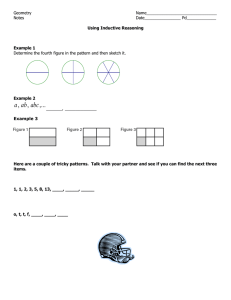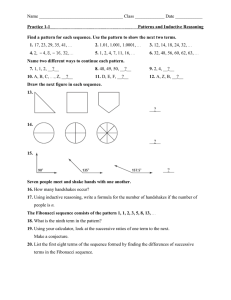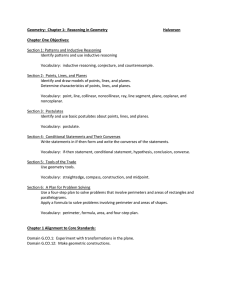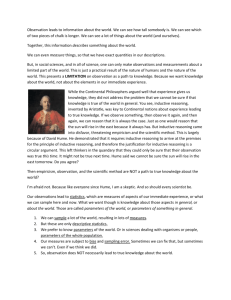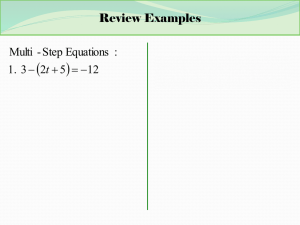Lesson 1 – Introduction and sections 1.1-1.2
advertisement
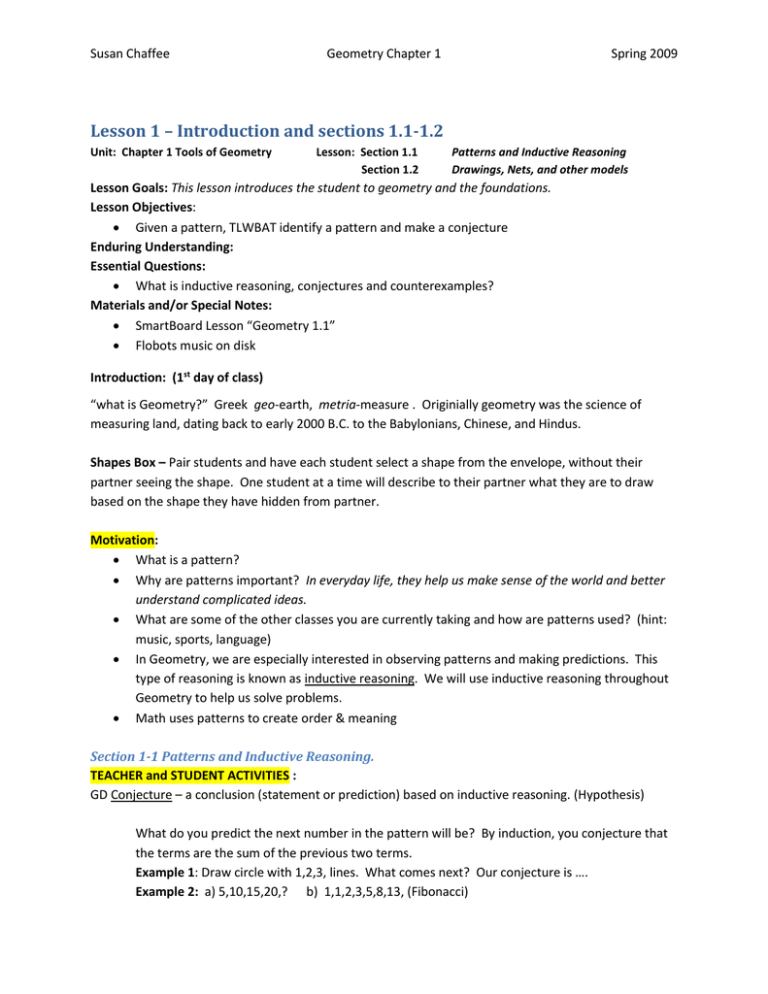
Susan Chaffee Geometry Chapter 1 Spring 2009 Lesson 1 – Introduction and sections 1.1-1.2 Unit: Chapter 1 Tools of Geometry Lesson: Section 1.1 Section 1.2 Patterns and Inductive Reasoning Drawings, Nets, and other models Lesson Goals: This lesson introduces the student to geometry and the foundations. Lesson Objectives: Given a pattern, TLWBAT identify a pattern and make a conjecture Enduring Understanding: Essential Questions: What is inductive reasoning, conjectures and counterexamples? Materials and/or Special Notes: SmartBoard Lesson “Geometry 1.1” Flobots music on disk Introduction: (1st day of class) “what is Geometry?” Greek geo-earth, metria-measure . Originially geometry was the science of measuring land, dating back to early 2000 B.C. to the Babylonians, Chinese, and Hindus. Shapes Box – Pair students and have each student select a shape from the envelope, without their partner seeing the shape. One student at a time will describe to their partner what they are to draw based on the shape they have hidden from partner. Motivation: What is a pattern? Why are patterns important? In everyday life, they help us make sense of the world and better understand complicated ideas. What are some of the other classes you are currently taking and how are patterns used? (hint: music, sports, language) In Geometry, we are especially interested in observing patterns and making predictions. This type of reasoning is known as inductive reasoning. We will use inductive reasoning throughout Geometry to help us solve problems. Math uses patterns to create order & meaning Section 1-1 Patterns and Inductive Reasoning. TEACHER and STUDENT ACTIVITIES : GD Conjecture – a conclusion (statement or prediction) based on inductive reasoning. (Hypothesis) What do you predict the next number in the pattern will be? By induction, you conjecture that the terms are the sum of the previous two terms. Example 1: Draw circle with 1,2,3, lines. What comes next? Our conjecture is …. Example 2: a) 5,10,15,20,? b) 1,1,2,3,5,8,13, (Fibonacci) Susan Chaffee Geometry Chapter 1 Spring 2009 Example 3: Flower petals. Observing a pattern does not guarantee it holds. Inductive reasoning gives us a statement to work with that we then prove or disprove. For now, we will talk about how to disprove. One way is through a Counterexample – an example which proves a conjecture as false. (put in GD) Example 4: any 3 points can be connected to form a triangle. Draw several triangles before showing the Counterexample: 3 collinear points. Example 5: If you use only straight lines, the number of pieces of pizza will always be twice the number of cuts. Ask class to find a counterexample. Example 6: The difference of 2 integers is less than either integer. Try 3 and -1. Group activity. Take out a blank piece of paper, put your name on it and write 2 conjectures, one true and one false. When students are done, have partners exchange and determine whether their partners are true and give counterexample to show false. Ask students to share some of their conjectures with the class. Lesson Closure: Noticing patterns are an important concept in understanding mathematics. We’ll continue to use the thought process of inductive reasoning throughout this class. Counterexamples are used to disprove a conjecture, deductive reasoning will be introduced in Chapter 2 for proving conjectures. Assignments: p.6, #1-6,9-12,17-19,22,24-26,30-34(even) Assessment: Formative: Writing conjectures with partner, turn this in during class as part of journaling exercise. Making 3D shapes from a 2D pattern on paper. Students will put their name on these and we will display in class. Summative:
